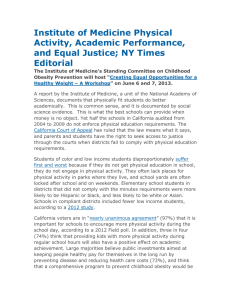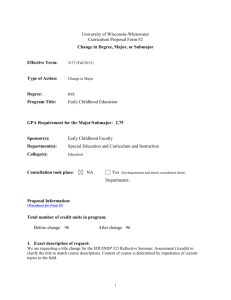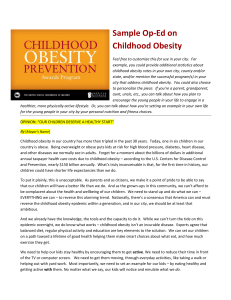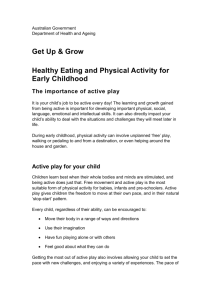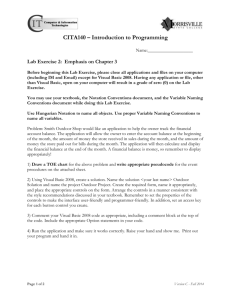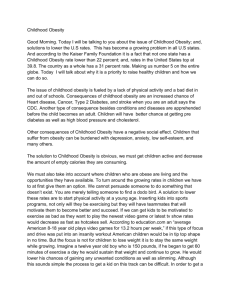Chapter 2 - Creating Curriculum
advertisement
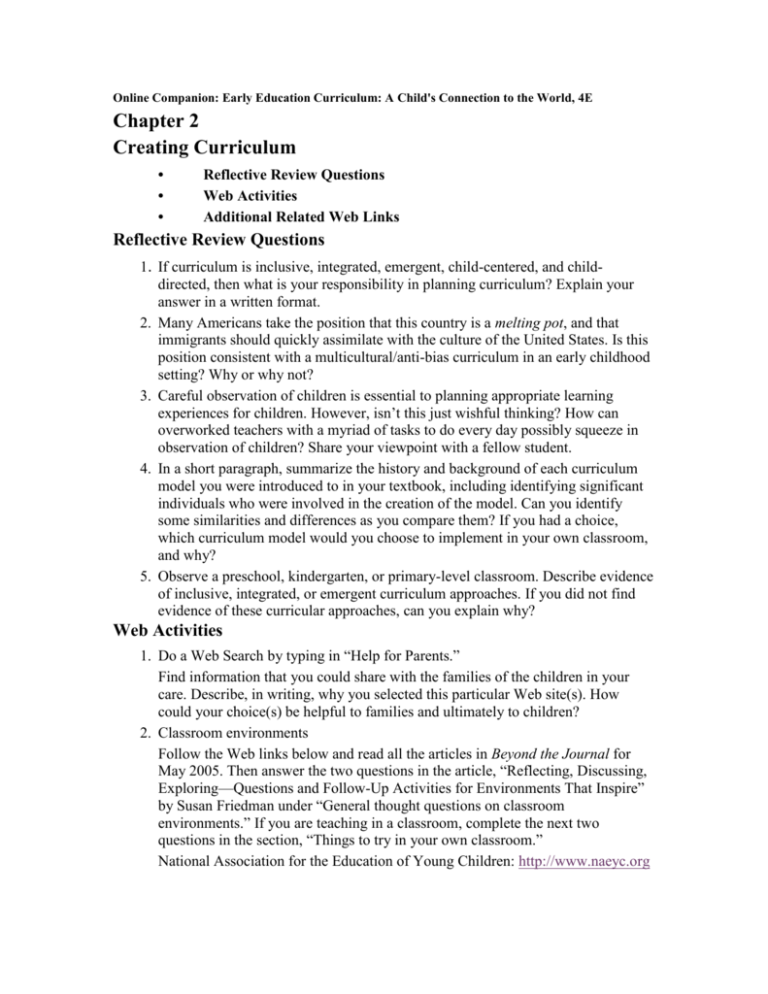
Online Companion: Early Education Curriculum: A Child's Connection to the World, 4E Chapter 2 Creating Curriculum • • • Reflective Review Questions Web Activities Additional Related Web Links Reflective Review Questions 1. If curriculum is inclusive, integrated, emergent, child-centered, and childdirected, then what is your responsibility in planning curriculum? Explain your answer in a written format. 2. Many Americans take the position that this country is a melting pot, and that immigrants should quickly assimilate with the culture of the United States. Is this position consistent with a multicultural/anti-bias curriculum in an early childhood setting? Why or why not? 3. Careful observation of children is essential to planning appropriate learning experiences for children. However, isn’t this just wishful thinking? How can overworked teachers with a myriad of tasks to do every day possibly squeeze in observation of children? Share your viewpoint with a fellow student. 4. In a short paragraph, summarize the history and background of each curriculum model you were introduced to in your textbook, including identifying significant individuals who were involved in the creation of the model. Can you identify some similarities and differences as you compare them? If you had a choice, which curriculum model would you choose to implement in your own classroom, and why? 5. Observe a preschool, kindergarten, or primary-level classroom. Describe evidence of inclusive, integrated, or emergent curriculum approaches. If you did not find evidence of these curricular approaches, can you explain why? Web Activities 1. Do a Web Search by typing in “Help for Parents.” Find information that you could share with the families of the children in your care. Describe, in writing, why you selected this particular Web site(s). How could your choice(s) be helpful to families and ultimately to children? 2. Classroom environments Follow the Web links below and read all the articles in Beyond the Journal for May 2005. Then answer the two questions in the article, “Reflecting, Discussing, Exploring—Questions and Follow-Up Activities for Environments That Inspire” by Susan Friedman under “General thought questions on classroom environments.” If you are teaching in a classroom, complete the next two questions in the section, “Things to try in your own classroom.” National Association for the Education of Young Children: http://www.naeyc.org (Click on “Beyond the Journal,” click on “Beyond the Journal Archives,” and then scroll down to May 2005, “Environments that Support Exploration and Learning” and click.) You can then click on different articles to gather information on creating environments that inspire children and teachers. 3. Consider this statement from your textbook: The rising number of children identified as overweight or obese is deemed a critical concern as overweight and obese children are at risk for serious medical ailments . . . social-emotional development can also be impaired (Greaser & Whyte, 2004 in Simpson & Gaus, 2006). The American Academy of Pediatrics is gravely concerned about the rise in obesity among children and young adults. Go to their Web site: http://www.aap.org (Under “Children’s Health Issues,” click on “Obesity”) After you examine some of this information, write a reflective summary of what you have learned and outline some steps you need to take to ensure the health of young children who will be in your care. 4. Another quote from your textbook stated the following: It is probably not a coincidence that childhood obesity is on the rise at a time when some elementary schools are reducing or eliminating recess and critics are calling for preschools to spend time focusing on academics and drills (Ginsberg, 2006). Do you think that this statement is true? Is recess disappearing from schools? Verify your opinion with some information gathered from research in the library and on-line. 5. Early Childhood News http://www.earlychildhoodnews.com (Click on “Articles,” click on “Physical Education and Movement,” and then click on “10 Factors to Consider When Designing Outdoor Play Areas” by Carolyn Tomlin) The outdoor play space also contributes to the physical well-being of children, but often the design of the outside play space is given little thought. Before you read the recommended article from the Early Childhood News Web site, jot down a list of points that you think need to be considered when planning outdoor play space for young children. Then read the article and compare your points with the factors in the article. Did you acquire some new information and inspiration? Additional Related Web Links 1. American Montessori Society http://www.amshq.org 2. 3. Culturally Responsive Curriculum: (Conduct a Web search by typing in “Culturally Responsive Curriculum: ERIC Digest”) Design Share http://www.designshare.com (In the Search box, type in “Comparing North American Reggio Schools”) 4. National Head Start Association http://www.nhsa.org 5. Parents Action for Children http://www.parentsaction.org 6. Project Approach http://www.projectapproach.org 7. Understanding Prejudice: Reading Room for Teachers http://www.understandingprejudice.org (Click on “Teacher’s Corner”)


